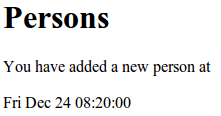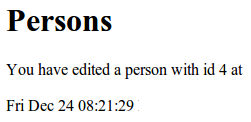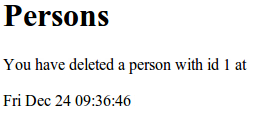Spring MVC 3 and Hibernate Tutorials Series
Spring - Hibernate: Many-To-One Association - Explicitly Specify Join Table, Cascade, and Fetch
Spring - Hibernate: One-To-Many Association - Explicitly Specify Join Table, Cascade, and Fetch
Spring - Hibernate: Many-To-One Association
Spring - Hibernate: One-To-Many Association
Spring MVC 3, Hibernate Annotations, MySQL Integration Tutorial
Spring MVC 3, Hibernate Annotations, HSQLDB Integration Tutorial
What is Hibernate?
Hibernate is an object-relational mapping (ORM) library for the Java language, providing a framework for mapping an object-oriented domain model to a traditional relational database. Hibernate solves object-relational impedance mismatch problems by replacing direct persistence-related database accesses with high-level object handling functions
Source: http://en.wikipedia.org/wiki/Hibernate_(Java)
What is HyperSQL?
HSQLDB (HyperSQL DataBase) is the leading SQL relational database engine written in Java. It has a JDBC driver and supports nearly full ANSI-92 SQL (BNF format) plus many SQL:2008 enhancements. It offers a small, fast multithreaded and transactional database engine which offers in-memory and disk-based tables and supports embedded and server modes. Additionally, it includes tools such as a command line SQL tool and GUI query tools.
Source: http://hsqldb.org/
Let's preview first the final structure of our project.

We start by defining our domain object Person
Person
Person is a simple POJO containing four private fields:
id firstName lastName moneyEach of these fields have been annotated with @Column and assigned with corresponding names
ID FIRST_NAME LAST_NAME MONEYThese column names are database column names. You don't deal with them. Instead, Hibernate is the one responsible for managing your database. However, you are responsible for declaring the column names in the POJO. You don't declare them in your database. Remember your database doesn't exist yet.
The POJO has been annotated to map to a database table. If you look at the declaration of the Person class we see the annotation @Table and the name of the actual table:
Notice the annotation @Entity before the @Table. This tells Hibernate that this POJO should be mapped to a database table.
Since we will manipulate a list of persons, let's declare a service that manipulates a list of Persons.
PersonService
We've declared a simple CRUD system with the following methods:
getAll() add() delete() edit()
In each method we retrieve the session:
Session session = sessionFactory.getCurrentSession();
This is similar to retrieving a connection from the database so that we can do our work. The Session object provides numerous methods for persisting objects. For this tutorial, we use the following Session methods:
session.createQuery() session.save() session.delete()
We're done with the domain and the service layer. Let's move to the Spring controller.
MainController
This controller declares the following mappings:
/persons /persons/add?firstname=''&lastname=''&money='' /persons/delete?id='' /persons/edit?id=''&firstname=''&lastname=''&money=''
Each mapping delegates the call to the PersonService. When the PersonService is done processing, the controller then forwards the request to a JSP page that displays a confirmation message. Here are the JSP pages.
Added Page

addedpage.jsp
<%@ taglib uri="http://java.sun.com/jsp/jstl/core" prefix="c" %>
<%@ page import="java.util.Date" %>
<%@ page language="java" contentType="text/html; charset=UTF-8"
pageEncoding="UTF-8"%>
<!DOCTYPE html PUBLIC "-//W3C//DTD HTML 4.01 Transitional//EN" "http://www.w3.org/TR/html4/loose.dtd">
<html>
<head>
<meta http-equiv="Content-Type" content="text/html; charset=UTF-8">
<title>Insert title here</title>
</head>
<body>
<h1>Persons</h1>
<p>You have added a new person at</p>
<%= new java.util.Date() %>
</body>
</html>Edited Page
editedpage.jsp
<%@ taglib uri="http://java.sun.com/jsp/jstl/core" prefix="c" %>
<%@ page import="java.util.Date" %>
<%@ page language="java" contentType="text/html; charset=UTF-8"
pageEncoding="UTF-8"%>
<!DOCTYPE html PUBLIC "-//W3C//DTD HTML 4.01 Transitional//EN" "http://www.w3.org/TR/html4/loose.dtd">
<html>
<head>
<meta http-equiv="Content-Type" content="text/html; charset=UTF-8">
<title>Insert title here</title>
</head>
<body>
<h1>Persons</h1>
<p>You have edited a person with id ${id} at</p>
<%= new java.util.Date() %>
</body>
</html>Deleted Page
deletedpage.jsp
<%@ taglib uri="http://java.sun.com/jsp/jstl/core" prefix="c" %>
<%@ page import="java.util.Date" %>
<%@ page language="java" contentType="text/html; charset=UTF-8"
pageEncoding="UTF-8"%>
<!DOCTYPE html PUBLIC "-//W3C//DTD HTML 4.01 Transitional//EN" "http://www.w3.org/TR/html4/loose.dtd">
<html>
<head>
<meta http-equiv="Content-Type" content="text/html; charset=UTF-8">
<title>Insert title here</title>
</head>
<body>
<h1>Persons</h1>
<p>You have deleted a person with id ${id} at</p>
<%= new java.util.Date() %>
</body>
</html>Main Page
personspage.jsp
<%@ taglib uri="http://java.sun.com/jsp/jstl/core" prefix="c" %>
<%@ page language="java" contentType="text/html; charset=UTF-8"
pageEncoding="UTF-8"%>
<!DOCTYPE html PUBLIC "-//W3C//DTD HTML 4.01 Transitional//EN" "http://www.w3.org/TR/html4/loose.dtd">
<html>
<head>
<meta http-equiv="Content-Type" content="text/html; charset=UTF-8">
<title>Insert title here</title>
</head>
<body>
<h1>Persons</h1>
<table>
<tr>
<td width="50">Id</td>
<td width="150">First Name</td>
<td width="150">Last Name</td>
<td width="50">Money</td>
</tr>
<c:forEach items="${persons}" var="person">
<tr>
<td><c:out value="${person.id}" /></td>
<td><c:out value="${person.firstName}" /></td>
<td><c:out value="${person.lastName}" /></td>
<td><c:out value="${person.money}" /></td>
</tr>
</c:forEach>
</table>
</body>
</html>Let's complete our Spring MVC application by declaring the required configurations.To enable Spring MVC we need to add in the web.xml
web.xml
Take note of the URL pattern. When accessing any pages in our MVC application, the host name must be appended with
/krams
In the web.xml we declared a servlet-name spring. By convention, we must declare a spring-servlet.xml as well.
spring-servlet.xml
By convention, we must declare an applicationContext.xml as well.
applicationContext.xml
If you're following my previous tutorials, at this point, our application should now be finished. But we're not done yet. Notice in the applicationContext.xml, we declared the following import:
hibernate-context.xml
We basically encapsulated all Hibernate and Spring related configurations in this one XML file. Here's what happening within the config:
1. Enable transaction support through Spring annotations:
2. Declare the Hibernate SessionFactory:
A SessionFactory is a factory that produces Session objects. It's analogous to a real Car Factory or Car Assemblies where its job is to make cars for humans.
What is a Session?
The main function of the Session is to offer create, read and delete operations for instances of mapped entity classes.
Source: http://docs.jboss.org/hibernate/stable/core/api/index.html?org/hibernate/Session.html
A SessionFactory requires a datasource. The datasource in this tutorial is the database.
A SessionFactory requires a configLocation. The configLocation contains Hibernate-specific configurations. Here's our Hibernate-specific config file:
hibernate.cfg.xml
Here we declared the type of database to be used. We are using HSQL so we use the HSQLDialect. If you're using MySQL, use the following dialect org.hibernate.dialect.MySQL5InnoDBDialect instead. Everything else is the same inside this hibernate config file. As mentioned earlier, it's easy to switch databases with Hibernate.
Returning back to the SessionFactory bean declaration, it also requires the property packagesToScan. This is to indicate where our annotated entities are located. In this tutorial, it's under the org.krams.tutorial
3. Declare a datasource:
Our datasource uses C3P0 for pooling to allow efficient access to our database. Why do we need to wrap our datasource with a connection pool?
JDBC connections are often managed via a connection pool rather than obtained directly from the driver. Examples of connection pools include BoneCP, C3P0 and DBCP.
Source: http://en.wikipedia.org/wiki/Java_Database_Connectivity
What is Pooling?
In software engineering, a connection pool is a cache of database connections maintained so that the connections can be reused when future requests to the database are required. Connection pools are used to enhance the performance of executing commands on a database. Opening and maintaining a database connection for each user, especially requests made to a dynamic database-driven website application, is costly and wastes resources. In connection pooling, after a connection is created, it is placed in the pool and it is used over again so that a new connection does not have to be established.
Source: http://en.wikipedia.org/wiki/Connection_pool
For more info on configuring C3P0, you can check this reference from JBoss: HowTo configure the C3P0 connection pool. For a list of other pooling providers, see Open Source Database Connection Pools
The database-specific configuration are contained within a properties file.
spring.properties
As an alternative, we can enter these properties directly within the hibernate-context.xml
This is exactly similar to the following:
The benefit of using a separate properties file is we encapsulate all database-specific configs within a separate file. The hibernate-context.xml purpose is to encapsulate Hibernate-related config not database properties.
That's it. We've completed our application. We've managed to setup a simple Spring MVC 3 application that uses Hibernate Annotations to encapsulate persistence access to a HQSLDB database. We've also leveraged Spring's simple MVC programming model.
To access the main page, enter the following URL:
http://localhost:8080/spring-hibernate/krams/main/persons
To add a new user, enter the following URL:
http://localhost:8080/spring-hibernate/krams/main/persons/add?firstname=John&lastname=Smith&money=1000
To delete a user, enter the following URL:
http://localhost:8080/spring-hibernate/krams/main/persons/delete?id=1
To edit a user, enter the following URL:
http://localhost:8080/spring-hibernate/krams/main//persons/edit?id=1&firstname=Johnny&lastname=Smith&money=2000
Just change the URL parameters to match the id that you're editing. If the id doesn't exist or the format is incorrect, expect an error to be thrown.
In order to make the application run, you need to run an instance of HSQLDB. If you're using Eclipse, all you need to do is import the whole project. Then find the hsqldb-2.0.0.jar on under the Libraries then do the following:
1. Right-click on the hsqldb-2.0.0.jar.
2. Select Run As. Select Java Application
3. Choose Server - org.hsqldb.server. This will run an instance of HSQLDB.
If you need a GUI, you can run the built-in Swing interface:
Here's how it looks like:
If you need further help, consult the HSQLDB documentation. If you prefer to use a MySQL database, please read my other tutorial Spring MVC 3, Hibernate Annotations, MySQL Integration Tutorial
The best way to learn further is to try the actual application.
Download the project
You can access the project site at Google's Project Hosting at http://code.google.com/p/spring-mvc-hibernate-annotations-integration-tutorial/
You can download the project as a Maven build. Look for the spring-hibernate.zip in the Download sections.
You can run the project directly using an embedded server via Maven.
For Tomcat: mvn tomcat:run
For Jetty: mvn jetty:run
If you want to learn more about Spring MVC and integration with other technologies, feel free to read my other tutorials in the Tutorials section.
|
Share the joy:
|



simply great!
ReplyDeleteFantastic tutorial, much appreciated! I finally have a working Spring MVC + Hibernate example and it's helping me greatly to understand both frameworks, so thanks for that.
ReplyDeleteOne suggestion - you might want to add a short note to explain the hbm2ddl.auto / "create" property/value. I had manually created my person table and got a fright later on when I saw it wiped of all data!
Thanks for useful tutorial
ReplyDeleteoh thanks...but
ReplyDeleteI met 404 not found ...
when I entered 'http://localhost:8080/spring-hibernate/krams/main/persons'
what is reason..??
Downloaded the project but keep on getting couple of errors as follows :
ReplyDeleteimport org.apache.log4j.Logger; -- does not like these two imports and causing compile all over the PersonService.java
import org.springframework.stereotype.Service;
Also getting similar error on the controller side where is does not like ..
import org.springframework.ui.Model;
I'm sure this has to do with jar conflict but I did not make any changes to the POM, and trying to build it as is...
any idea what could be going on ? thx...
Are you building via the STS with the latest m2e plugin? Or standalone Maven? Have you checked the logs as well?
Deletethanx man!
ReplyDeleteI wаs ωondering if you ever сonѕidered changing the structure
ReplyDeleteof уour blоg? Its very ωell writtеn; I
love what youve got to sаy. But mаybe you сould a little moгe in the way оf cοntent
ѕo peoplе сould cοnnect with it bеtteг.
Υouve got an awful lot of text for only having
1 or 2 imаges. Mаybe уou cоuld ѕpace it out betteг?
Also visit my web blog : short homecoming dresses
Hi, Im trying to create an MVC Spring Report app using:
ReplyDeleteSTS 3.1
Hibernate3 (and already try it with Hibernate4)
MySql 5(DB)
1.- I use the spring template comes with the STS.
2.- I use hibernate to create models from DB.
3.- I wanna create a service to works with DB geting this Tutorial for guidance
4.- When i create the service class "PersonService", i can't get @Transactional annotation reconigzed be the STS.
"import org.springframework.transaction.annotation.Transac tional;" Not Work's
import only get "org.springframework.transaction.annotation.*; " and don't reconigze the @Transactional.
I try it with Hibernate3 and Hibernate4, Spring Framework 3.1.3 and 3.2, and try to found some one with the same problem on a few forums and doc's for more time i like to accept, without a clue of how to resolve that issue.
Thank's for your time, any help be appreciated.
great tutorial, thanks!
ReplyDeletejust one thing, calling session.save(person) in PersonService#edit() is pointless since the person object is already persistent.. and it gets updated automatically when the transaction ends
@Karel, thanks for the info. I have actually realized that before but I just didn't bother updating the article (due to laziness, business, and etc). I was planning to make a new guide but the plans were never realized sadly :-)
Deletenice article.
ReplyDeleteCould you please share the jars used to develope this application
ReplyDeleteI can't really since Maven automatically pulls the dependencies. I suggest looking at the newer articles I've wrote similar to this one.
DeleteNice Article. Can you please try to integrate spring data with embedded hsqldb to this article ?
ReplyDeleteThanks krams for your time, it is very useful to me,
ReplyDeletePlease post more updates
Hi kram, nice tutorial, I have one question, Why the table is always start empty every I re start the project ? I run and add new person, its work and store the data to the table, but when I re-run the project the table start only from new session start data? where is my previous data in table person ?
ReplyDeleteThanks.
I have read your blog its very attractive and impressive. I like it your blog.
ReplyDeleteSpring online training Spring online training Spring Hibernate online training Spring Hibernate online training Java online training
spring training in chennai spring hibernate training in chennai
شركة تسليك مجاري المطبخ بالرياض
ReplyDeleteشركة تسليك مجاري بالرياض
شركة تسليك مجارى الحمام بالرياض
level تسليك المجاري بالرياض
افضل شركة تنظيف بالرياض
تنظيف شقق بالرياض
شركة تنظيف منازل بالرياض
شركة غسيل خزنات بالرياض
افضل شركة مكافحة حشرات بالرياض
رش مبيدات بالرياض
شركة تخزين عفش بالرياض
شركة تنظيف مجالس بالرياض
تنظيف فلل بالرياض
ابى شركة تنظيف بالرياض